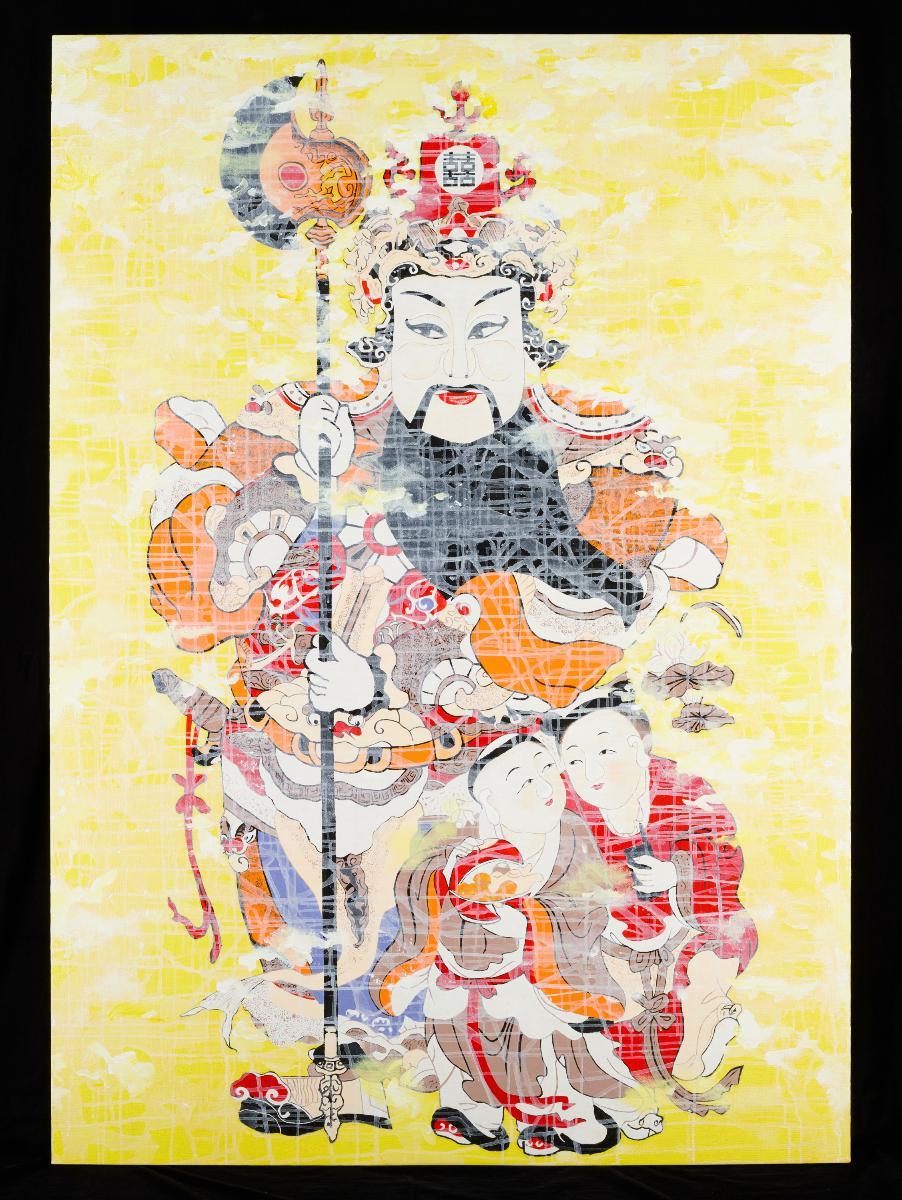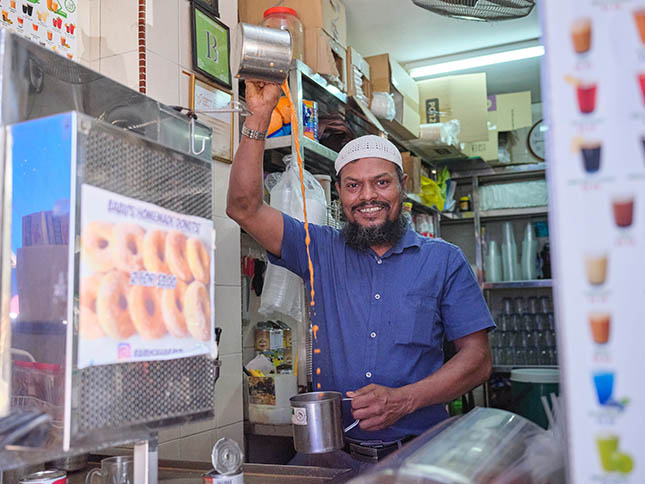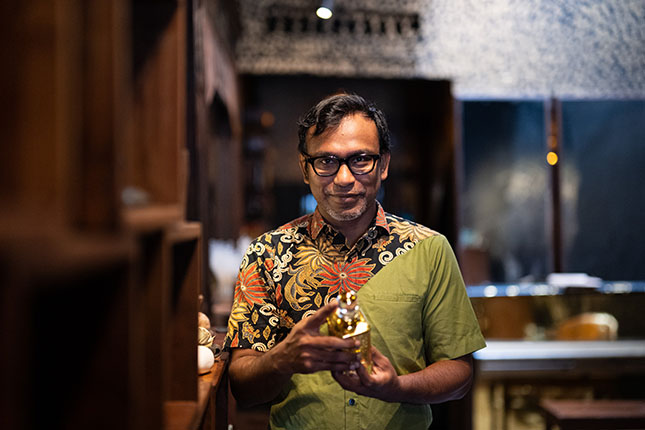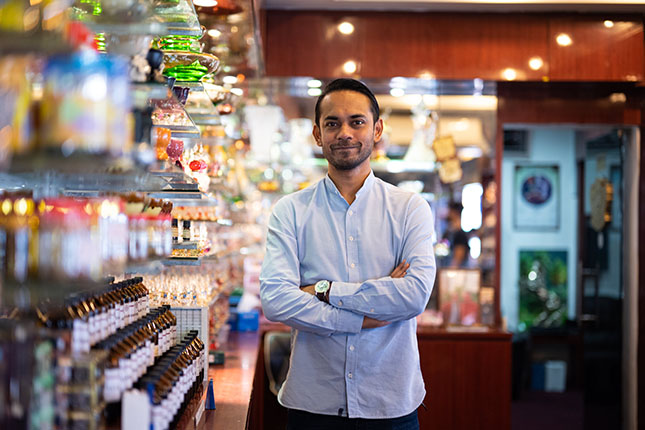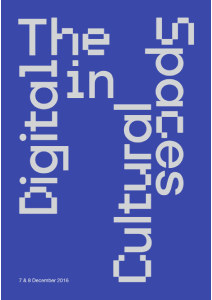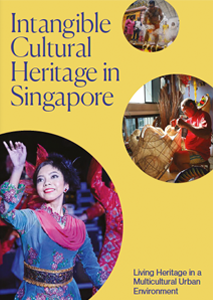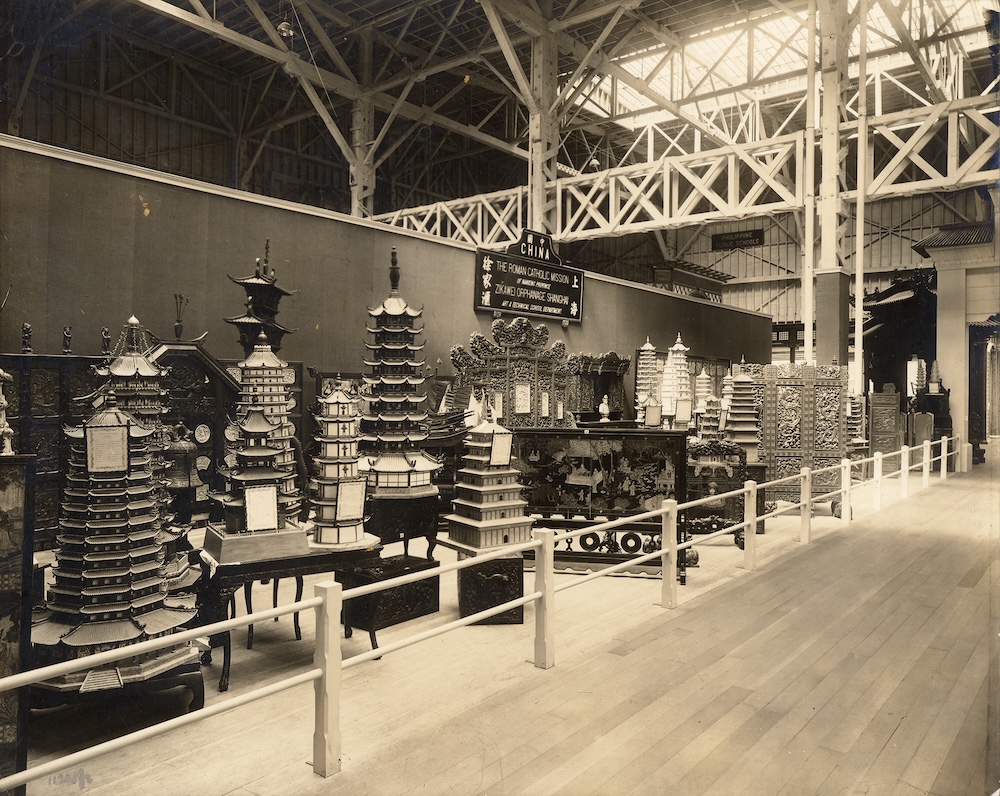Minyak Attar
Aromatics and its many uses have been present in various cultures across the world. In Singapore, the use and application of aromatics is of particular significance amongst the Muslim community (which include Malay, Indian, and Arab Muslims), and one of which is the use of minyak attar (essential oils in Malay). In the Islamic procedure of religious ablution and presenting oneself in a clean state before God, applying minyak attar is a way of completing the cleansing process and perfuming oneself before entering a mosque for prayer.
Introduction
Aromatics and its many uses have been present in various cultures across the world. In Singapore, the use and application of aromatics is of particular significance amongst the Muslim community (which include Malay, Indian, and Arab Muslims), and one of which is the use of minyak attar (essential oils in Malay). In the Islamic procedure of religious ablution and presenting oneself in a clean state before God, applying minyak attar is a way of completing the cleansing process and perfuming oneself before entering a mosque for prayer.
Geographic Location
The use and prominence of minyak attar in Singapore and the region gradually increased with the arrival of Islam, given its prominence in Islamic culture. Believed to have been derived from the Persian word ‘atr’ meaning ‘fragrance,’ 'attar' (also known as 'ittar' or 'othr') is an Arabic word which means 'scent,’ and the practice remains prevalent in the Middle East. In the context of Singapore, Kampong Gelam became a focal point in this trade.
Communities Involved
In Singapore, the use of minyak attar is commonplace among the Muslim community, and the trade and sale of the product can generally be found in the areas historically associated with the community - Kampong Gelam in particular, and Geylang Serai, to a lesser extent.
Associated Social and Cultural Practices
In the Islamic faith, the concept of hygiene and piety was linked to the wearing of perfume as agreeable scents are regarded as an important facet of spiritual energy and as a representation of divine qualities. These beliefs and the knowledge related to such practices may be formally transmitted through religious classes and informally within families and have contributed to the spread and use of perfumery within the Muslim community.
The making of minyak attar is an intricate process that requires astute knowledge of scents and the development of detailed formulas. This knowledge is typically passed down from a small pool of masters to apprentices. Some of the processes associated with the production of minyak attar are as follows:
- Gathering Key Ingredients
Several types of perfumed wood are used to make minyak attar, such as myrrh, musk, sandalwood and agarwood, with agarwood being a key ingredient. Agarwood is one of the most prized aromatics in the Arab world, and has been cited in many ancient doctrines for its medicinal and aromatic properties. Today, Muslims in Singapore continue the practice of burning agarwood splinters or chips to produce incense during special religious occasions, particularly at gatherings, such as during Ramadan prayers in the lead up to Hari Raya Haji. - Mixing Ingredients
The mix of ingredients used in minyak attar accounts for the uniqueness of the fragrance. The craftsperson would have to choose an appropriate means of extraction to draw the perfume from raw ingredients. The viscosity of the product also plays a part in determining how it is applied on the body. Spray perfumes and oil perfumes require different applicators to be used, minayk attar – as an oil perfume – require rods or rollers for application. - Distillation
There are two common ways of distillation, both of which are suitable for the production of minyak attar - steam distillation and hydro-distillation. Steam distillation is a common technique for obtaining aromatic compounds where the key ingredients are chipped, sun-dried, crushed and then placed in a distillation still with water and heated until its compounds are extracted from the wood and re-collected through condensation of the distilled vapour. Hydro-distillation on the other hand is a more traditional method of extraction which involves soaking the plant material in water and then boiling it until the oil is released. This method is not used as much anymore because of the high costs and time associated with heating large quantities of water. - Expression
Before the discovery of distillation, all essential oils were extracted through pressing. Most citrus peel oils are expressed mechanically or cold-pressed. This is a time- and cost-efficient method if the raw plant material contains large quantities of oil. - Other Celebrations, Festive Occasions and Reasons
After extraction, the extracted oil is left to settle before being mixed to form other products or sold as a standalone product.
Experience of a Practitioner
Mr Johari Kazura, a third-generation practitioner, runs Sifr Aromatics, an extension of Kazura Company - one of the oldest minyak attar businesses in Kampong Gelam, started by Mr Johari’s grandfather Mr Mohamed Hanifa Kazura in 1933. Mr Kazura used to sell minyak attar to devotees of Sultan mosque who would apply minyak attar before they entered for their weekly prayers. Given the increasing demand for minyak attar from the local community, Mr Kazura focused solely on perfumes and was the first shop in Singapore to produce roll-on perfumes. Today, Mr Johari who learnt the craft and trade from his father Mr Jamal bin Mohamad Hanifa, has started to blend more-traditional perfumery with modern aromatics to broaden appeal to the younger generation and the wider community. Mr Johari introduced customisation of scents at his shop, and keeps records of different formulas, compounds and ingredients he has used to create a particular scent. With this database, he personally evaluates its appeal to customers’ tastes and how it might suit their specific needs. Moreover, given the widespread use of e-commerce, he has clients from all around the world, and to further diversify and differentiate his range of products, the customised perfumed blends he sells come in hand-painted glass bottles.
Watch: Sifr Aromatics
Present Status
It is still common practice for the Muslim community in Singapore today to use aromatic compounds, such as minyak attar on a daily basis. According to Mr Johari, apart from its use by weekly mosque congregations, essential oils and minyak attar are increasingly perceived to be everyday products just like other commercial perfumes. The main challenge that the minyak attar industry faces is mainly one of economic viability as larger industrial perfumeries manufacturing aromatics at cheaper prices with economies of scale impact the continuation of the craft by individual perfumers like Mr Johari. Nonetheless, Mr Johari believes that this trade will continue to remain relevant with evolution of the craft and broader appeal to the wider community.
References
Reference No.: ICH-105
Date of Inclusion: March 2024
Abu Bakar Sidik, Nurdiyana. “Comparison of Gaharu (Aquilaria Malaccensis) Essential Oil Composition between Each Country.” B. Eng. Thesis, Faculty of Chemical Engineering and Natural Resource, Pekan: University Malaysia Pahang, 2008.
Aljunied Brothers. “Dehen Oud / Oud.” Dehen Oud. Accessed February 26, 2021. https://www.aljuniedbrothers.com/c-50-dehenoudoud.html.
Amin, Hidayah. Leluhur: Singapore's Kampong Gelam. Singapore: Helang Books, 2019.
Antonopoulou, Marina, James Compton, Razan Al-Mubarak, and Lisa S Perry. The Trade and Use of Agarwood in the United Arab Emirates - Wildlife Trade Report from TRAFFIC, October 20, 2010. https://www.traffic.org/publications/reports/the-trade-and-use-of-agarwood-in-the-united-arab-emirates/.
Berita Harian. “Bau-Bauan Beralkohol Halal Digunakan.” Berita Harian. February 5, 1988.
Boswell, Rosabelle. “Scents of Identity: Fragrance as Heritage in Zanzibar.” Journal of Contemporary African Studies 26, no. 3 (2008): 295–311. https://doi.org/10.1080/02589000802332507.
Burkill, I. H. A Dictionary of the Economic Products of the Malay Peninsula. Kuala Lumpur, Malaysia: Ministry of Agriculture and Co-operatives, 1966.
Chakrabarty, Kalyan, Kumar Ashok, and Vivek Menon. Rep. Trade in Agarwood. New Delhi, India: TRAFFIC India, 1994.
Chan, Margaret. “Ritual Is Theatre, Theatre Is Ritual : Tang-Ki: Chinese Spirit Medium Worship.” WorldCat. Singapore : Wee Kim Wee Centre, Singapore Management University, 2006. https://worldcat.org/oclc/728952512.
Compton, James, and Akiko Ishihara. Rep. The Use and Trade of Agarwood in Japan. A TRAFFIC reoprt to CITES Secretariat, 2004.
Donkin, R. A. Dragon's Brain Perfume: an Historical Geography of Camphor. Boston: Brill, 1999.
Edward, Maxwell William. “The Law and Customs of the Malays with Reference to the Tenure of Land.” Journal of the Straits Branch of the Royal Asiatic Society 13 (1884): 75–220.
Fisher, Charles, and Paul Wheatley. “Geographical Notes on Some Commodities Involved in Sung Maritime Trade.” The Geographical Journal 129, no. 3 (1963): 348. https://doi.org/10.2307/1794843.
Griffith, Ralph Thomas Hotchkin, trans. The Hymns of the Rigveda. E. J. Lazarus, 1889-1892.
Hashim, Norhaiza. “Minyak Atar Dan Kayu Gaharu Jadikan Aljunied Brothers 'Semerbak Harum.” Berita Harian, February 11, 2015. https://www.beritaharian.sg/ekoniaga/minyak-atar-dan-kayu-gaharu-jadikan-aljunied-brothers-semerbak-harum.
Hoogervorst, Tom. “Manliness in Sino-Malay Publications in the Netherlands Indies.” South East Asia Research 24, no. 2 (2016): 283–307. https://doi.org/10.1177/0967828x16649313.
Howes, F. N. “Age-Old Resins of the Mediterranean Region and Their Uses.” Economic Botany 4, no. 4 (1950): 307–16. https://doi.org/10.1007/bf02985086.
Kathirithamby-Wells, J. Nature and Nation: Forests and Development in Peninsular Malaysia. Honolulu: University of Hawai'i Press, 2005.
Lim, Teck Wyn, and Nooraine Awang Anak. Rep. Wood for the Trees: A Review of the Agarwood (Gaharu) Trade in Malaysia. Petaling Jaya, Malaysia: TRAFFIC Southeast Asia, 2010.
Lin, Melissa. “Sifr Experiment Pays off for Jamal Kazura Perfume Business.” The Straits Times, March 29, 2017. https://www.straitstimes.com/singapore/sifr-experiment-pays-off-for-jamal-kazura-perfume-business.
López-Sampson, Arlene, and Tony Page. “History of Use and Trade of Agarwood.” Economic Botany 72, no. 1 (2018): 107–29. https://doi.org/10.1007/s12231-018-9408-4.
Mazalan, M. 2005. "Pengalaman En. Mazalan Mohamed sebagai Pengusaha Kayu Karas di Jajahan Gua Musang." Seminar on Gaharu in Kelantan in conjunction with 34th World Forestry Day. Kota Bharu, Kelantan, March 24.
Newbold, Thomas John. Political and Statistical Account of the British Settlements in the Straits of Malacca, Viz. Pinang, Malacca, and Singapore with a History of the Malayan States on the Peninsula of Malacca. 1. Vol. 1. 2 vols. J Murray, 1839.
Osman, Salim. “Hari Raya Di Kampung Dan Flat Tak Banyak Beza.” Berita Harian. August 1, 1980.
Rhind, Jennifer. Fragrance and Wellbeing: Plant Aromatics and Their Influence on the Psyche. London: Singing Dragon, 2014.
Salleh, Saini. “Niaga Minyak Atar Hasil Buatan Sendiri.” Berita Harian. June 3, 1988.
Schottenhammer, Angela. “Transfer of Xiangyao 香藥 from Iran and Arabia to China – A Reinvestigation of Entries in the Youyang Zazu 酉陽雜俎.” Essay. In Aspects of the Maritime Silk Road: from the Persian Gulf to the East China Sea, edited by Ralph Kauz, 117–49. Wiesbaden: Harrassowitz, 2009.
Shakyh, H. M. C. The Book of Sufi Healing. New York: Inner Traditions International, 1985.
Tarling, Nicholas. The Cambridge History of Southeast Asia: Volume 1: from Early Times to C.1800. Cambridge England: Cambridge University Press, 1992.
Tibbetts, Gerald. The Malay Peninsula as Known to the Arab Geographers. Singapore: University of Malaya, 1956.
Tregonning, K. G. Under Chartered Company Rule: North Borneo, 1881-1946. Singapore: University of Malaya Press, 1959.
Um, Nancy. “Nested Containers for Maritime Journeys: Tools of Aromatic Diplomacy around the Late Seventeenth- and Early Eighteenth-Century Indian Ocean.” West 86th: A Journal of Decorative Arts, Design History, and Material Culture 25, no. 2 (2018): 199–223. https://doi.org/10.1086/702323.
Wade, Geoff. In Champa in the Song Hui-Yao: a Draft Translation. 53. Singapore: Asia Research Institute, National University of Singapore, 2005.
Walker, J. H. Power and Prowess: the Origins of Brooke Kingship in Sarawak. Crows Nest, NSW, Australia: Allen & Unwin, 2002.
Wilkinson, Richard James. A Malay-English Dictionary: Romanised. London: Macmillan, 1957.
Zohar, Amar, and Efraim Lev. “Trends in the Use of Perfumes and Incense in the Near East after the Muslim Conquests.” Journal of the Royal Asiatic Society of Great Britain & Ireland 23, no. 1 (2013): 11–30. https://doi.org/10.1017/s1356186312000673.













